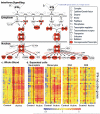An interferon-inducible neutrophil-driven blood transcriptional signature in human tuberculosis
- PMID: 20725040
- PMCID: PMC3492754
- DOI: 10.1038/nature09247
An interferon-inducible neutrophil-driven blood transcriptional signature in human tuberculosis
Abstract
Tuberculosis (TB), caused by infection with Mycobacterium tuberculosis, is a major cause of morbidity and mortality worldwide. Efforts to control it are hampered by difficulties with diagnosis, prevention and treatment. Most people infected with M. tuberculosis remain asymptomatic, termed latent TB, with a 10% lifetime risk of developing active TB disease. Current tests, however, cannot identify which individuals will develop disease. The immune response to M. tuberculosis is complex and incompletely characterized, hindering development of new diagnostics, therapies and vaccines. Here we identify a whole-blood 393 transcript signature for active TB in intermediate and high-burden settings, correlating with radiological extent of disease and reverting to that of healthy controls after treatment. A subset of patients with latent TB had signatures similar to those in patients with active TB. We also identify a specific 86-transcript signature that discriminates active TB from other inflammatory and infectious diseases. Modular and pathway analysis revealed that the TB signature was dominated by a neutrophil-driven interferon (IFN)-inducible gene profile, consisting of both IFN-gamma and type I IFN-alphabeta signalling. Comparison with transcriptional signatures in purified cells and flow cytometric analysis suggest that this TB signature reflects changes in cellular composition and altered gene expression. Although an IFN-inducible signature was also observed in whole blood of patients with systemic lupus erythematosus (SLE), their complete modular signature differed from TB, with increased abundance of plasma cell transcripts. Our studies demonstrate a hitherto underappreciated role of type I IFN-alphabeta signalling in the pathogenesis of TB, which has implications for vaccine and therapeutic development. Our study also provides a broad range of transcriptional biomarkers with potential as diagnostic and prognostic tools to combat the TB epidemic.
Figures




Comment in
-
Infectious disease: The tuberculosis signature.Nat Rev Immunol. 2010 Oct;10(10):677. doi: 10.1038/nri2854. Nat Rev Immunol. 2010. PMID: 20879165 No abstract available.
References
-
- Dye C, Floyd K, Uplekar M. WHO report. World Health Organization; Geneva: 2008.
Publication types
MeSH terms
Substances
Associated data
- Actions
- Actions
- Actions
- Actions
- Actions
- Actions
- Actions
Grants and funding
- R01 AR050770-01/AR/NIAMS NIH HHS/United States
- P50 ARO54083/PHS HHS/United States
- 088316/WT_/Wellcome Trust/United Kingdom
- R01 AR050770/AR/NIAMS NIH HHS/United States
- 1 U19 AI082715-01/AI/NIAID NIH HHS/United States
- U117565642/MRC_/Medical Research Council/United Kingdom
- U19 AI057234/AI/NIAID NIH HHS/United States
- U117588499(88499)/MRC_/Medical Research Council/United Kingdom
- U19 AIO57234-02/PHS HHS/United States
- P50 AR054083/AR/NIAMS NIH HHS/United States
- U19 AI082715/AI/NIAID NIH HHS/United States
- MC_U117588499/MRC_/Medical Research Council/United Kingdom
- P01 CA084512/CA/NCI NIH HHS/United States
- U01 AI082110/AI/NIAID NIH HHS/United States
- MC_U117565642/MRC_/Medical Research Council/United Kingdom
LinkOut - more resources
Full Text Sources
Other Literature Sources
Medical
Molecular Biology Databases

